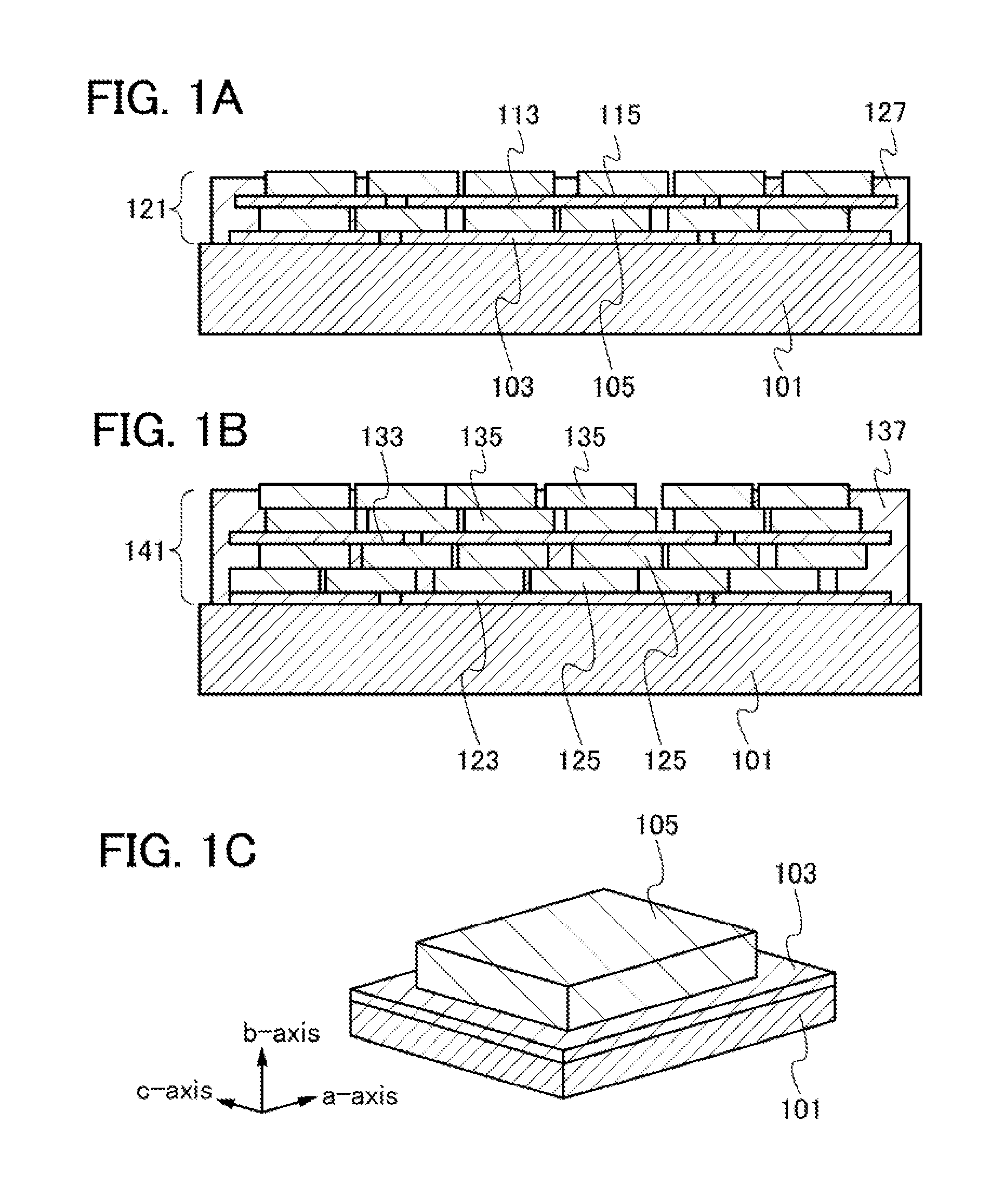Lithium-ion secondary battery
a secondary battery and lithium-ion technology, applied in the manufacture of final products, cell components, electrochemical generators, etc., can solve the problems of limiting the increase of discharge capacity and energy density, and achieve the effect of reducing resistance of the positive electrode active material layer, reducing the proportion of positive electrode active material, and easy diffusion
- Summary
- Abstract
- Description
- Claims
- Application Information
AI Technical Summary
Benefits of technology
Problems solved by technology
Method used
Image
Examples
embodiment 1
[0023]In this embodiment, a positive electrode of a lithium-ion secondary battery according to one embodiment of the present invention and a manufacturing method thereof will be described with reference to FIGS. 1A to 1C, FIG. 2, and FIGS. 3A to 3E.
[0024]FIGS. 1A and 1B are each a cross-sectional view of a positive electrode of a lithium-ion secondary battery.
[0025]As illustrated in FIG. 1A, graphenes 103 serving as a conduction auxiliary agent are provided over a positive electrode current collector 101. Lithium-containing composite oxides 105 which are a positive electrode active material are provided over the graphenes 103. Graphenes 113 serving as a conduction auxiliary agent are provided over the lithium-containing composite oxide 105. Lithium-containing composite oxides 115 which are a positive electrode active material are provided over the graphenes 113. That is to say, the graphenes and the lithium-containing composite oxides are alternately stacked. Gaps between the graphe...
embodiment 2
[0067]In this embodiment, a method for forming over a positive electrode current collector a positive electrode including a positive electrode active material layer in which gaps are filled with a solid electrolyte will be described.
[0068]In this embodiment, in the positive electrode active material layer described in Embodiment 1, the binder includes a solute of an electrolyte of a lithium-ion secondary battery.
[0069]FIG. 4 illustrates the positive electrode according to this embodiment.
[0070]As illustrated in FIG. 4, the graphenes 103 and the lithium-containing composite oxides 105 are stacked in this order over the positive electrode current collector 101. Further, the graphenes 113 are provided over the lithium-containing composite oxides 105, and the lithium-containing composite oxides 115 are stacked over the graphenes 113. Furthermore, a binder 187 including a solute of an electrolyte and serving as a solid electrolyte of a lithium-ion secondary battery is provided in gaps be...
embodiment 3
[0083]In this embodiment, a lithium-ion secondary battery and a manufacturing method thereof will be described.
[0084]A lithium-ion secondary battery according to this embodiment will be described with reference to FIG. 6. Here, a cross-sectional structure of the lithium-ion secondary battery will be described below.
[0085]FIG. 6 is a cross-sectional view of the lithium-ion secondary battery.
[0086]A lithium-ion secondary battery 400 includes a negative electrode 411 including a negative electrode current collector 407 and a negative electrode active material layer 409, a positive electrode 405 including a positive electrode current collector 401 and a positive electrode active material layer 403, and a separator 413 provided between the negative electrode 411 and the positive electrode 405. Note that the separator 413 is impregnated with an electrolyte. The negative electrode current collector 407 is connected to an external terminal 419 and the positive electrode current collector 40...
PUM
| Property | Measurement | Unit |
|---|---|---|
| length | aaaaa | aaaaa |
| angle | aaaaa | aaaaa |
| thickness | aaaaa | aaaaa |
Abstract
Description
Claims
Application Information
 Login to View More
Login to View More - R&D
- Intellectual Property
- Life Sciences
- Materials
- Tech Scout
- Unparalleled Data Quality
- Higher Quality Content
- 60% Fewer Hallucinations
Browse by: Latest US Patents, China's latest patents, Technical Efficacy Thesaurus, Application Domain, Technology Topic, Popular Technical Reports.
© 2025 PatSnap. All rights reserved.Legal|Privacy policy|Modern Slavery Act Transparency Statement|Sitemap|About US| Contact US: help@patsnap.com



